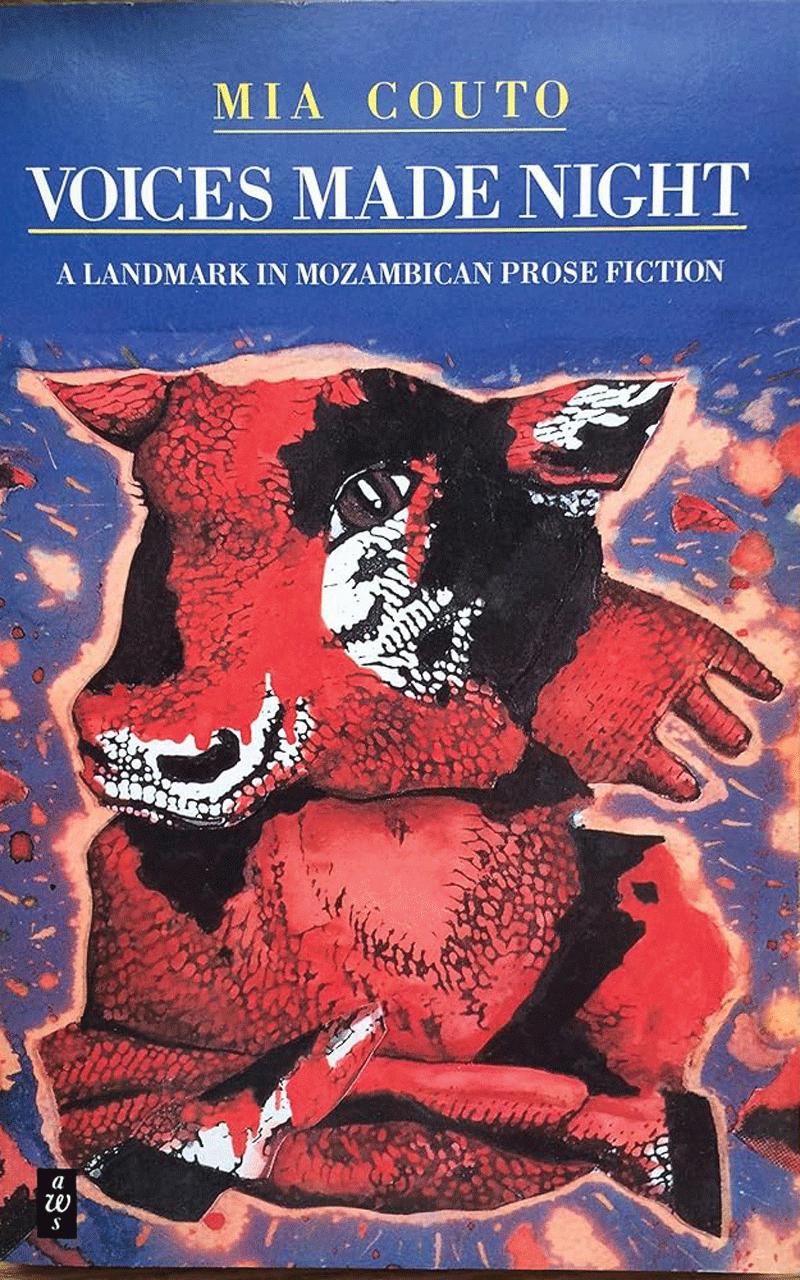
I love short stories and have read nearly all key short story books from the rest of the southern African sub region. But, I kick myself for not having read Mozambican writer, Mia Couto’s short story book called Voices Made Night. It was published way back in 1986 but its strength is something to talk about.
These short stories take in all the varieties that I have seen from across the African continent. In this book there are strong elements of African folklore, the intriguing tendencies of magical realism, the inhibiting and titillating abstraction and the wonders of edgeless art. I read on, sometimes failing to predict where this little book translated from Portuguese by David Brookshaw would take me.
The first short story called The Fire is almost an Aesopian tale. A very old man stays at the edge of the village with his equally old wife and all their children are long dead. Just from nowhere he says to his wife, “I am thinking.” The bemused wife asks, “What is it you are thinking, husband?” The husband goes on as if in a dream: “If you die, how shall I, alone, sick and without strength, how shall I bury you?” Then he touches his wife by hand and goes straight to his point: “We are poor, all we have is nothingness. Nor do we have anybody else. I think it is better that we start digging your grave now.”
So he starts digging his wife’s grave when his wife is still living! He thinks that this is a full demonstration of his love for his wife. He is assuming that it is his wife who should die first. He is going against tradition. He starts to slowly dig his wife’s grave. The wife has the dire misfortune of seeing her own grave being dug! But all she says to him is: “How good you are, my husband! I was lucky to have you as the man of my life.”
But he is too old for this task even when he pushes himself day by day to do the digging. She even tries to help him by going to the grave being dug and saying to him, “Don’t dig too deep. I want to be near the top, just below the ground, so that I’ll almost be able to touch life a little.” And he answers her, “Very well. I shan’t put much earth on top of you.”
The long and short of it is that the husband falls sick and dies while he is still digging the grave. It is him who is buried in this grave. The irony is that in hoping that he is digging someone’s grave, he is digging his own grave!
The Talking Raven’s last Warning is a story that is as scary as it is intriguing. Zuze Paraza, a retired painter who is a chain smoker spits out of his chest both phlegm and a raven ant a public place. As soon as the black raven comes out of the insides of Zuze Paraza it starts to speak out real human words. It turns out that the raven just does not speak ordinary words but is prophetic. The bird is a seer. People come from far and wide to hear about the wishes of their deer departed, the circumstances and whereabouts of their ancestors. Through the intermediary of the raven, they are given answers to their questions. Requests come flocking in immediately. Zuze no longer has a room, it is an office. He no longer talks to people but conducts a surgery of sorts. He gives special concessions, keeps a long waiting list of appointments and then makes his clients wait. His opportunism brings forth his downfall eventually. This is a parable about the rise from rags to riches and then back to rags!
My favourite story from this collection is called Patanhoca The Lovesick Snake Catcher. In this story you find the title phrase for the whole book, “voices made night.” This is my favourite story because I do not fully grasp its import! It is edgeless and I like the struggle that I have with this story.
Work without edges is a phenomenon in art that refers to art that tickles the consumer through its lack of definitive meaning. Edgeless art is not driven by a desire to be understood but by a desire to draw out experience as felt by the artist in its original dream like state, without giving away predictable meaning. You may say the poet’s obligation in that kind of writing is to tell the story with the most beautiful and thrilling language possible, to extend and expand even what is possible with language and real-life situations.
In this story, there are suggestions that it is Patanhoca who kills the Chinese widow woman who owns a shop in the area of Muchatazina, for no particular reason. Some people actually think that nobody kills her but that she dies of natural causes.
In this transcendental story, Chinawoman Mississe comes all the way from China to own a store. She is thought to be a widow but nobody knows how and why she left China to come and settle in the backwaters of Mozambique. It is said when she arrives in Mozambique, she is actually still young. She turns down many suitors including the Portuguese colonial masters. She is all alone and yet she is such a terrible beauty. But she drinks all kinds of wines and one day she is heard crying out drunkenly, “My Children! Give me back my children, murderer.”
Then Patanhoca, the snake catcher, appears to visit her one night and they drink. She somehow coerces him towards her bed. She is dying to sleep with him. Then suddenly it appears that the African snake catcher and the Chinese woman have a common past that goes many years back in China! This is a story that could twist even the mind of the most intelligent reader. Who kills who and why?
In this book there are stories that begin in very beautiful ways, opening up slowly and uneasily like a flower in the sun. One story begins: “It is a truth: the dead ought not to return, to cross the frontier of their world. They only come and disturb our sadness. We already know for sure: so and so has gone. We comfort widows, shed all our tears. On the other hand, there are those dead who, having died, persist in coming back…”
Then yet another story begins this way: “I are sad. No, I’m not mistaken. What I’m saying is correct, or, perhaps: we am sad? Because inside me, I am not alone. I am many. And they all fight over my one and only life. We go along reaping our deaths. But we only have one birth. That’s where the problem lies. That’s why, when I tell my story, I mix myself up, a mulatto not of races, but of existences…”
The story called The Day Mabata-bata Exploded brought me close to tears. With a child at the centre of it, it is clearly reminiscent of the stories of the other great Mozambican writer, Luis Bernardo Honwana. An orphaned boy, Azarias, is herding his uncle’s cattle in perfect peace when the bull of the herd explodes into pieces!
Azarias is stunned. He thinks the bolt that has shattered the bull is a lightning flash. But on second thought he thinks that it cannot be lightning because the sky was clear, blue without the slightest smudge. He even thinks that it is the ndlati, the bird of lightning is still in the sky and may actually strike again. Azarias is afraid of his uncle and plans to run away. As he is contemplating his escape, it is learnt that the explosion has come out of a landmine planted by one of the conflicting sides in the war going on in Mozambique between Frelimo and the Portuguese who are still ruling Mozambique. But as the boy walks towards the villagers, hoping that now he is being sent to school like the other children, he steps on another landmine…
Perhaps the most comic tragic story in the whole collection is The Barber’s Most Famous Customer. As a way of making his work popular in the surroundings, Firipe Beruberu he claims that he once cut the hair of the famous American film star, Sidney Poitier. He boasts: “Look at this photo. Can you see this fellow? See how nice his hair is: it was cut here, with these very hands of mine. I scissored him without knowing what his importance was. I just saw that he spoke English. I am telling you: this fellow brought his head all the way from over there in America to this barber’s shop of mine.”
News spreads around that barber Firipe Beruberu entertains American visitors and that it is through him that the Americans are supporting Frelimo. Subsequently Firipe is arrested for it and his shop is razed to the ground.
Mia Couto was born in 1955 in the Mozambican city of Beira. In the early 1970’s he moved to Maputo to begin medical studies but did not continue because of his involvement in the independence struggle and the start of a career in journalism.
Couto was to become director of the Mozambique information Agency, and the magazine Tempo and later the official daily newspaper Noticias. His poems have appeared in Mozambican magazines since he was 14 and in 1983 his first volume of poetry Raiz de orvalho (Roots of Dew) was published. Vozes Anoitecidas, now translated as Voices made Night, was first published in Mozambique in 1986, meriting a second edition there the following year. Subsequently it was published in Portugal and Italy, where it gained wide critical acclaim. The stories have also been adapted for radio and stage.
Mia Couto is of white Portuguese parentage. He was once described as a “white man with an African soul.” Challenged on how he works within black traditions when he is white, he once said: “I’m a white guy and an African; the son of Europeans and Mozambicans; a scientist living in a very religious world; a writer in an oral society. These are apparently contradictory worlds that I like to unite because they’re part of me.” He adds, “when I think of a character, it’s a black person; 99% of Mozambicans are black … I want to tell stories in the borderlines, and which cross frontiers…”
About the reviewer
Memory Chirere is a Zimbabwean writer. He enjoys reading and writing short stories and some of his stories are published in No More Plastic Balls (1999), A Roof to Repair (2000), Writing Still (2003) and Creatures Great and Small(2005). He has published short story books; Somewhere in This Country (2006), Tudikidiki (2007) and Toriro and His Goats (2010). Together with Maurice Vambe, he compiled and edited (so far the only full volume on Mungoshi called): Charles Mungoshi: A Critical Reader (2006). His new book is a 2014 collection of poems entitled: Bhuku Risina Basa Nekuti Rakanyorwa Masikati. He is with the University of Zimbabwe (in Harare) where he lectures in literature. Email: memorychirere@yahoo.com










